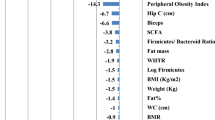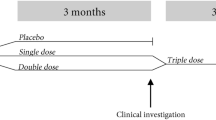Abstract
Background/Objectives:
In spite of the much evidence for the beneficial effects of probiotics, their anti-obesity effects have not been well examined. We evaluated the effects of the probiotic Lactobacillus gasseri SBT2055 (LG2055) on abdominal adiposity, body weight and other body measures in adults with obese tendencies.
Subjects/Methods:
We conducted a multicenter, double-blind, randomized, placebo-controlled intervention trial. Subjects (n=87) with higher body mass index (BMI) (24.2–30.7 kg/m2) and abdominal visceral fat area (81.2–178.5 cm2) were randomly assigned to receive either fermented milk (FM) containing LG2055 (active FM; n=43) or FM without LG2055 (control FM; n=44), and were asked to consume 200 g/day of FM for 12 weeks. Abdominal fat area was determined by computed tomography.
Results:
In the active FM group, abdominal visceral and subcutaneous fat areas significantly (P<0.01) decreased from baseline by an average of 4.6% (mean (confidence interval): −5.8 (−10.0, −1.7) cm2) and 3.3% (−7.4 (−11.6, −3.1) cm2), respectively. Body weight and other measures also decreased significantly (P<0.001) as follows: body weight, 1.4% (−1.1 (−1.5, −0.7) kg); BMI, 1.5% (−0.4 (−0.5, −0.2) kg/m2); waist, 1.8% (−1.7 (−2.1, −1.4) cm); hip, 1.5% (−1.5 (−1.8, −1.1) cm). In the control group, by contrast, none of these parameters decreased significantly. High-molecular weight adiponectin in serum increased significantly (P<0.01) in the active and control groups by 12.7% (0.17 (0.07, 0.26) μg/ml) and 13.6% (0.23 (0.07, 0.38) μg/ml), respectively.
Conclusion:
The probiotic LG2055 showed lowering effects on abdominal adiposity, body weight and other measures, suggesting its beneficial influence on metabolic disorders.
This is a preview of subscription content, access via your institution
Access options
Subscribe to this journal
Receive 12 print issues and online access
$259.00 per year
only $21.58 per issue
Buy this article
- Purchase on SpringerLink
- Instant access to full article PDF
Prices may be subject to local taxes which are calculated during checkout
Similar content being viewed by others
References
Abate N, Garg A (1995). Heterogeneity in adipose tissue metabolism: causes, implications and management of regional adiposity. Prog Lipid Res 34, 53–70.
Buijs RM, Kreier F (2006). The metabolic syndrome: a brain disease? J Neuroendocrinol 18, 715–716.
Cani PD, Amar J, Iglesias MA, Poggi M, Knauf C, Bastelica D et al. (2007). Metabolic endotoxemia initiates obesity and insulin resistance. Diabetes 56, 1761–1772.
Cariou B, van Harmelen K, Duran-Sandoval D, van Dijk TH, Grefhorst A, Abdelkarim M et al. (2006). The farnesoid X receptor modulates adiposity and peripheral insulin sensitivity in mice. J Biol Chem 281, 11039–11049.
DiBaise JK, Zhang H, Crowell MD, Krajmalnik-Brown R, Decker GA, Rittmann BE (2008). Gut microbiota and its possible relationship with obesity. Mayo Clin Proc 83, 460–469.
Elli M, Callegari ML, Ferrari S, Bessi E, Cattivelli D, Soldi S et al. (2006). Survival of yogurt bacteria in the human gut. Appl Environ Microbiol 72, 5113–5117.
Elwood PC, Pickering JE, Hughes J, Fehily AM, Ness AR (2004). Milk drinking, ischaemic heart disease and ischaemic stroke II. Evidence from cohort studies. Eur J Clin Nutr 58, 718–724.
Food and Agriculture Organization and World Health Organization Expert Consultation (2001). Evaluation of Health and Nutritional Properties of Powder Milk and Live Lactic Acid Bacteria. Food and Agriculture Organization of the United Nations and World Health Organization: Cordoba, Argentina. Available from: ftp://ftp.fao.org/es/esn/food/probio_report_en.pdf (Accessed 7 October 2009).
Fox CS, Massaro JM, Hoffmann U, Pou KM, Maurovich-Horvat P, Liu CY et al. (2007). Abdominal visceral and subcutaneous adipose tissue compartments: association with metabolic risk factors in the Framingham Heart Study. Circulation 116, 39–48.
Fujimoto WY, Abbate SL, Kahn SE, Hokanson JE, Brunzell JD (1994). The visceral adiposity syndrome in Japanese-American men. Obes Res 2, 364–371.
Fujiwara S, Seto Y, Kimura A, Hashiba H (2001). Establishment of orally-administered Lactobacillus gasseri SBT2055SR in the gastrointestinal tract of humans and its influence on intestinal microflora and metabolism. J Appl Microbiol 90, 343–352.
Guarner F, Perdigon G, Corthier G, Salminen S, Koletzko B, Morelli L (2005). Should yoghurt cultures be considered probiotic? Br J Nutr 93, 783–786.
Hamad EM, Sato M, Uzu K, Yoshida T, Higashi S, Kawakami H et al. (2009). Milk fermented by Lactobacillus gasseri SBT2055 influences adipocyte size via inhibition of dietary fat absorption in Zucker rats. Br J Nutr 101, 716–724.
Hara K, Horikoshi M, Yamauchi T, Yago H, Miyazaki O, Ebinuma H et al. (2006). Measurement of the high-molecular weight form of adiponectin in plasma is useful for the prediction of insulin resistance and metabolic syndrome. Diabetes Care 29, 1357–1362.
Imai E, Fukui K, Ohta N, Tomitsuka T, Seto Y, Fujiwara S et al. (2002). Effects of Lactobacillus gasseri SBT2055 on dextran sulfate sodium-induced ulcerative colitis model in rats. Bioscience Microflora 21, 179–183.
Jayaprakasha HM, Yoon YC, Paik HD (2005). Probiotic functional dairy foods and health claims: an overview. Food Sci Biotechnol 14, 523–528.
Kajimoto O, Hirata H, Aoe S, Takahashi T, Suzuki Y, Tanaka H (2002). Fermented milk containing Lactobacillus gasseri (SP strain) decreases serum cholesterol concentration in men with boundary and mild hypercholesterolemia. Jpn J Lactic Acid Bacteria (in Japanese) 13, 114–124.
Kawai Y, Saito T, Uemura J, Itoh T (1997). Rapid detection method for bacteriocin and distribution of bacteriocin-producing strains in Lactobacillus acidophilus group lactic acid bacteria isolated from human feces. Biosci Biotechnol Biochem 61, 179–182.
Kawai Y, Saitoh B, Takahashi O, Kitazawa H, Saito T, Nakajima H et al. (2000). Primary amino acid and DNA sequences of gassericin T, a lactacin F-family bacteriocin produced by Lactobacillus gasseri SBT2055. Biosci Biotechnol Biochem 64, 2201–2208.
Kobayashi H, Ouchi N, Kihara S, Walsh K, Kumada M, Abe Y et al. (2004). Selective suppression of endothelial cell apoptosis by the high molecular weight form of adiponectin. Circ Res 94, e27–e31.
Kyrou I, Chrousos GP, Tsigos C (2006). Stress, visceral obesity, and metabolic complications. Ann NY Acad Sci 1083, 77–110.
Ley RE, Turnbaugh PJ, Klein S, Gordon JI (2006). Microbial ecology: human gut microbes associated with obesity. Nature 444, 1022–1023.
Mater DD, Bretigny L, Firmesse O, Flores MJ, Mogenet A, Bresson JL et al. (2005). Streptococcus thermophilus and Lactobacillus delbrueckii subsp. Bulgaricus survive gastrointestinal transit of healthy volunteers consuming yogurt. FEMS Microbiol Lett 250, 185–187.
Matsuzawa Y, Funahashi T, Kihara S, Shimomura I (2004). Adiponectin and metabolic syndrome. Arterioscler Thromb Vasc Biol 24, 29–33.
Nakashima R, Kamei N, Yamane K, Nakanishi S, Nakashima A, Kohno N (2006). Decreased total and high molecular weight adiponectin are independent risk factors for the development of type 2 diabetes in Japanese-Americans. J Clin Endocrinol Metab 91, 3873–3877.
Nieves DJ, Cnop M, Retzlaff B, Walden CE, Brunzell JD, Knopp RH et al. (2003). The atherogenic lipoprotein profile associated with obesity and insulin resistance is largely attributable to intra-abdominal fat. Diabetes 52, 172–179.
Sanz Y, Santacruz A, De Palma G (2008). Insights into the roles of gut microbes in obesity. Interdiscip Perspect Infect Dis 2008, 829101. (article ID) 9 pages.
Sato M, Uzu K, Yoshida T, Hamad EM, Kawakami H, Matsuyama H et al. (2008). Effects of milk fermented by Lactobacillus gasseri SBT2055 on adipocyte size in rats. Br J Nutr 99, 1013–1017.
Takahashi H, Fujita T, Suzuki Y, Benno Y (2006). Monitoring and survival of Lactobacillus gasseri SBT2055 in the human intestinal tract. Microbiol Immunol 50, 867–870.
Tchernof A, Lamarche B, Prud’Homme D, Nadeau A, Moorjani S, Labrie F et al. (1996). The dense LDL phenotype. Association with plasma lipoprotein levels, visceral obesity, and hyperinsulinemia in men. Diabetes Care 19, 629–637.
Teegarden D (2005). The influence of dairy product consumption on body composition. J Nutr 135, 2749–2752.
Tennyson CA, Friedman G (2008). Microecology, obesity, and probiotics. Curr Opin Endocrinol Diabetes Obes 15, 422–427.
Terry RB, Wood PD, Haskell WL, Stefanick ML, Krauss RM (1989). Regional adiposity patterns in relation to lipids, lipoprotein cholesterol, and lipoprotein subfraction mass in men. J Clin Endocrinol Metab 68, 191–199.
Turnbaugh PJ, Ley RE, Mahowald MA, Magrini V, Mardis ER, Gordon JI (2006). An obesity-associated gut microbiome with increased capacity for energy harvest. Nature 444, 1027–1031.
Usman, Hosono A (1999). Bile tolerance, taurocholate deconjugation, and binding of cholesterol by Lactobacillus gasseri strains. J Dairy Sci 82, 243–248.
van Harmelen V, Skurk T, Rohrig K, Lee YM, Halbleib M, Aprath-Husmann I et al. (2003). Effect of BMI and age on adipose tissue cellularity and differentiation capacity in women. Int J Obes Relat Metab Disord 27, 889–895.
Waki H, Yamauchi T, Kamon J, Ito Y, Uchida S, Kita S et al. (2003). Impaired multimerization of human adiponectin mutants associated with diabetes. Molecular structure and multimer formation of adiponectin. J Biol Chem 278, 40352–40363.
Yun SI, Park HO, Kang JH (2009). Effect of Lactobacillus gasseri BNR17 on blood glucose levels and body weight in a mouse model of type 2 diabetes. J Appl Microbiol 21, 21.
Zemel MB (2005). The role of dairy foods in weight management. J Am Coll Nutr 24, 537S–546S.
Acknowledgements
We deeply thank the subjects for their cooperation, and Dr K Mashiko at Kodama Central Hospital, Dr Y Itagaki at Yuki Clinic, Dr M Ishiguro at Ishiguro Clinic, Dr T Kanematsu at Kameido-minamiguchi Clinic, Dr Y Mizuno at Mizuno Internal Medical Clinic, Dr S Tashiro at Prime Clinic, Dr S Dantsuka at Dantsuka Clinic, Dr Y Taguchi at Megumidai Clinic, Dr K Samejima at Samejima Bonding Clinic, Mr K Watanabe at Esucal Laboratories Co. Ltd. and staff members of Isogo Central and Neurosurgical Hospital and the above facilities.
Author information
Authors and Affiliations
Corresponding author
Ethics declarations
Competing interests
The authors declare no conflict of interest.
Additional information
Supplementary Information accompanies the paper on European Journal of Clinical Nutrition website
Supplementary information
Rights and permissions
About this article
Cite this article
Kadooka, Y., Sato, M., Imaizumi, K. et al. Regulation of abdominal adiposity by probiotics (Lactobacillus gasseri SBT2055) in adults with obese tendencies in a randomized controlled trial. Eur J Clin Nutr 64, 636–643 (2010). https://doi.org/10.1038/ejcn.2010.19
Received:
Revised:
Accepted:
Published:
Issue Date:
DOI: https://doi.org/10.1038/ejcn.2010.19
Keywords
This article is cited by
-
Evaluation of probiotic bifidobacteria strains from Iranian traditional dairy products for their anti-hyperlipidemic potential
Folia Microbiologica (2024)
-
Effect of different doses of Lacticaseibacillus paracasei K56 on body fat and metabolic parameters in adult individuals with obesity: a pilot study
Nutrition & Metabolism (2023)
-
Maternal intermittent fasting in mice disrupts the intestinal barrier leading to metabolic disorder in adult offspring
Communications Biology (2023)
-
Effects of synbiotic supplementation on anthropometric indices and body composition in overweight or obese children and adolescents: a randomized, double-blind, placebo-controlled clinical trial
World Journal of Pediatrics (2023)
-
Probiotics’ effect on visceral and subcutaneous adipose tissue: a systematic review of randomized controlled trials
European Journal of Clinical Nutrition (2022)



